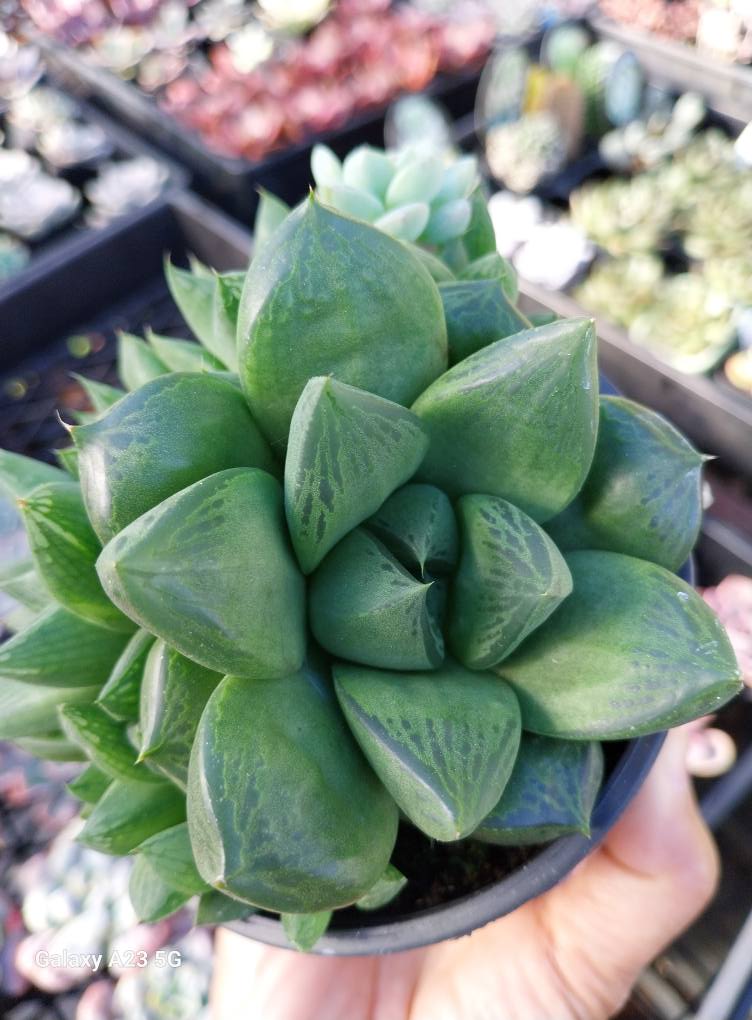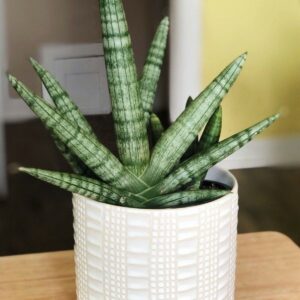✨ The Plump Rosette Succulent is known as Haworthia turgida.
South Africa is the birthplace of the little, lovely, and simple-to-cultivate succulent Haworthia turgida. It is a member of the Asphodelaceae family and is well-known for its thick, glistening rosettes of translucent-tipped leaves. The name “turgida” alludes to the plant’s thick, water-filled leaves that are adapted for dry climates, meaning “swollen or turgid.”
Because of its appealing appearance and low maintenance needs, this species is ideal for terrariums, succulent collections, and windowsills.
A look at botany
Haworthia turgida is the scientific name.
Family: Asphodelaceae
Common names: Only the scientific term is widely used.
Source: South Africa
Growth Pattern: succulent forming small, clustered rosettes
Size:
Height: 2–4 inches (5–10 cm)
Width: 3–5 inches (7–12 cm)
Exterior
Leaves:
Triangular leaves that are thick, meaty, and have pointed ends.
Semi-translucent or windowed tips, which let sunlight into the interior of the leaf for photosynthesis
Frequently, it is a pale to brilliant green hue that changes to reddish or bronze when exposed to sunlight.
Development Shape:
Over time, it forms dense clumps of numerous rosettes.
Its dense, ground-hugging shape is a result of its natural habitat in rocky fissures.
Flowers:
The inflorescence is made up of tiny, tubular, white to light pink blooms on long, thin stalks.
Mostly flowers in the spring and summer
☀ Lighting Needs
Inside:
Prefers strong, indirect light
A window facing north or east is effective.
Although it can withstand reduced light levels, it thrives with enough light to preserve its shape and hue.
outside:
Prefers partial shade to dappled sunshine.
To prevent leaf burn, shield from intense midday sunlight
Some people are drawn to the reddish or bronzy tones that mild stress can produce.
Temperature and humidity
Temperature:
Optimum range: 18–27°C (65–80°F)
Although it can survive temperatures as low as 5°C (41°F) for a short period of time, it is not frost-hardy.
USDA zones 9–11 are suitable for it.
Humidity:
likes humidity levels between low and medium
Fungal problems can arise from insufficient air circulation combined with high humidity.
Watering Schedule
Spring to Autumn (Active Growth):
Water when the top one or two inches of soil are dry
The frequency is usually between 10 and 14 days, depending on the environment.
Use the “soak and dry” approach, which involves watering the soil well before letting it dry out entirely.
Winter (Dormancy):
Water less often, perhaps once every three to four weeks
Water only enough to keep the leaves from drying out.
The main risk is overwatering, which frequently causes root rot.
Requirements for Soil
Kind:
Requires gritty soil that drains well
Recommended combination:
50% succulent/cactus soil
25% pumice or perlite
25% grit or rough sand
pH: somewhat acidic to neutral (6.0–7.0)
To prevent water buildup, pots should have adequate drainage holes.
Adding fertilizer
Use fertilizer in the spring and summer:
Use a succulent fertilizer with a balanced and diluted half-strength concentration.
Give food once every 4–6 weeks
During the fall and winter, when development slows down, there is no need to apply fertilizer.
Pruning and maintenance
Little pruning is necessary.
Remove:
Leaves that are broken, dead, or dried out
Blooming flower stalks that have bloomed
Gently wiping leaves on a regular basis gets rid of dust and promotes good development.
🌱 Reproduction
Offsets (Pups):
Easily generates offsets around the base
When pups have a few roots, remove them with a clean knife.
After letting it dry for a day or two, replant it in dry dirt.
Leaf Cutting:
Because this species favors offset propagation, it is less prevalent.
Seeds: For home gardeners, this is feasible but less practical and takes longer.
Common Issues
Overwatering: results in leaves that are soft, translucent, or mushy
Underwatering results in dry, shriveled leaves.
Pests: Seldom seen, but could draw:
Mealy bugs
Spider mites
Insects that are scaled
Regular inspection helps identify problems early. If necessary, use neem oil or insecticidal soap.
Toxicness
Typically safe for both animals and people
It’s still a good idea to keep it out of reach of inquisitive kids or pets.
Ornamental Application
Great for:
Displays on windowsills
Small succulent gardens
terrariums (open and well-ventilated)
Tabletop adornment
Due to its small size, gorgeous leaf designs, and simplicity of maintenance, Haworthia turgida is a popular addition to any succulent collection.
✅ Conclusion
Haworthia turgida is a lovely, resilient, and forgiving succulent that is ideal for gardeners of all skill levels. It can thrive for years with brilliant indirect light, attentive watering, and well-draining soil, gradually increasing in number through offsets and bringing lush greenery to compact areas.
Office Plants, Succulents
Haworthia turgida
₨799.00
Haworthia turgida
Compact rosette-form succulent with glossy green leaves and easy-care traits, perfect for terrariums and bright spots.





Reviews
There are no reviews yet.